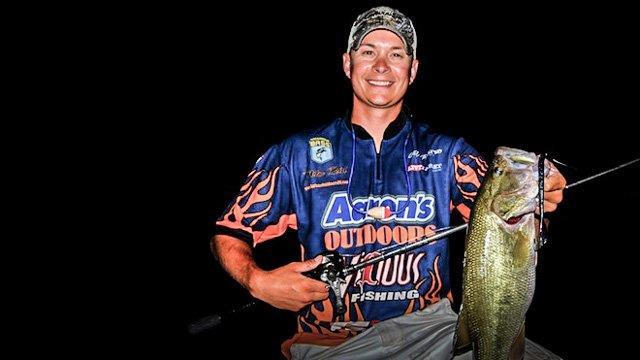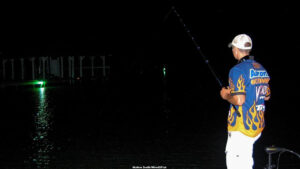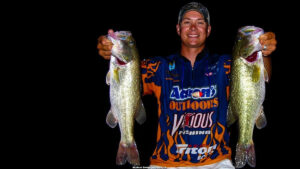The bass fishing has been really tough in my area for the last several weeks. So tough, in fact, that I’ve recently been sitting in a deer stand far more often than fishing. I had pretty much thrown in the towel. But I unknowingly made an awesome decision a few weeks ago.
The sun was setting fast on another subpar fishing day and just as I was preparing to put my boat on the trailer and head home, I spotted a dock light shining in the distance. I couldn’t help myself. I trolled towards it, made a half-hearted cast and to my utter surprise, caught a 6-pounder.
That single fish has opened my eyes to a whole new arena of fall bass fishing. I’ve spent nearly every night since targeting dock lights and studying nighttime bass behavior while enjoying some of the most incredible fishing of the year. I’m talking roughly 50 to 75 fish in just two or three hours— no exaggeration.
I’ve been making notes and paying close attention to each contributing factor in order to help you enjoy the same success. Here’s what I’ve found.
Isolated dock lights are preferred
For the same reason I’d rather flip and pitch isolated blowdowns as opposed to long, monotonous stretches during daylight hours, I make a concerted effort to locate secluded dock lights. Creeks and pockets adorned with numerous dock lights tend to scatter the population of fish while these dock lights concentrate everything into one area— bugs, baitfish, bluegill, crappie and bass.
My most recent experiences have validated my reasoning. When fishing areas filled with dock lights, I’ve noticed very little baitfish activity under each light. I’ll see a few smaller balls of shad in the area but it’s fairly underwhelming, to say the least. I’ve caught a few bass on these lights as well but they’ve been difficult to come by.
Look for the green lights: On average, I catch more quantity and quality around green-colored dock lights. They’re not easy to find, but for some reason tend to be high-percentage areas.
If I’m able to find an isolated light, however, the activity levels are simply astounding. I’ll see tens of thousands of shad circling in front of the dock, dozens of big gizzard shad and the occasional dark shadow dart through the light for an easy meal. These are the special lights that have often yielded 20 or 30 bass in as many casts.
Fortunately, this is a pretty easy strategy to duplicate on most lakes right now. Most folks who use their lake homes on a seasonal basis don’t stick around once the chilly temperatures set in, so there won’t be as many dock lights turned on. You may have to ride around for a while before you find one, but when you do, it’ll likely be loaded with quality bass.
Don’t overlook the edges
It’s tempting to make repetitive casts to the brightest part of a light—and sometimes it pays off and we’ll get to that in a second—but don’t overlook the outside edges where the light fades to darkness. I’m willing to bet these areas are where you’ll catch your biggest bass of the evening.
It makes a lot of sense when you relate it to daytime schooling activity. It can be difficult to catch a quality bass in the middle of a surface feeding frenzy because, quite simply, big bass are both smart and lazy. They’re not as fast as those 14-inchers and they’re smart enough to conserve their precious energy, which is why you’ll often catch the biggest bass beneath the heart of the activity.
The same goes with dock light fishing. You might catch a random 5-pounder in the smack-dab middle of the light, but the majority of them will be silently stalking the outside edge in order to avoid feeding competition. The intense light blinds the shad to the outer world—just like someone shining a flashlight directly into your eyes—so the older, wiser bass will use that to their advantage and utilize the surrounding darkness as a strategic ambush point.
The one-two punch from which I rarely deviate
All of us, myself included, probably bring too much gear whenever we’re fishing. Even if I’m on a killer pattern that’s sure to hold up, my boat is still loaded to the gills with random baits and lures. It’s tough to break old habits.
When I’m fishing dock lights, however, I keep my tackle selection as simple as I possibly can. Regardless of the conditions or time of year, I use two baits that have accounted for some unforgettable nights on the water.
- Start lipless— Even though you’re targeting fish in or around a bright light, I tend to believe that their vision is slightly impaired when compared to daylight hours. I used to fish a lot of crankbaits around lights with moderate success, but both my quantity and quality have skyrocketed since I’ve started using lipless crankbaits. Why do they work so well? I think it’s all about the sound. The bass can feel and hear them coming from several feet away and they’ll absolutely crush ‘em. I prefer 1/2-ounce lipless cranks because their castability allows me to maintain a healthy distance from the light.
- Finish big— After picking off the most aggressive fish with a lipless crankbait, I always make sure to throw a dark-colored big worm on a 3/16-ounce Texas rig around the edges of the light to target the larger, more inactive bass. These worms move a bunch of water and allow the bass to locate them quickly. On average, I’ll drag the worm one foot every 30 seconds, so it can get boring at times, but stick with it— this is probably your best shot at a true giant.
Quick tip: Sometimes it takes nighttime bass a bit longer to eat your lure or bait. If you delay your hooksets a bit, you’ll notice a much higher hookup ratio.
Don’t give ‘em long
It’s easy to waste a lot of time fishing dock lights. You’re making fairly repetitive casts, there’s not much scenery and if you’re not careful, you can go into “zombie mode” and spend an entire hour on a single light. I try to turn it into a numbers game. In my mind, the more isolated dock lights I can fish, the better chance I have of hooking up with ol’ big.
I’ve found that fall bass give themselves away very quickly on dock lights. In the summer, you might have to coax them and be more stubborn but I don’t think that’s the case this time of year. I’ll usually make 10 or so casts with a lipless crankbait and if I don’t get bit, I’ll make three or four casts with a big worm to saturate the outside edges. If they don’t respond after that, my trolling motor is up and I’m on to the next one.
You’re targeting nomadic bass
There’s no doubt that some docks offer everything a bass could possibly need to survive throughout the entire year— easy access to both shallow and deep water, suitable cover such as brush piles and an abundant population of forage. But in most cases, the bass are traveling to these lights after-hours to take advantage of the easy pickings.
- If you get hung, don’t freak out— I’ve fished with buddies in the past who act like it’s the end of the world if you get hung on a brush pile or dock post when fishing lights. A poorly placed cast may ruin the short-term action on a specific dock, but that doesn’t mean you can’t return to the dock in an hour and slay ‘em. There will be bass “stopping by” these lights all night long so don’t be too hard on yourself if you screw up. You can come back later and there will probably be more new and uneducated bass to catch.
- Don’t get stubborn—If you have an incredible night on a specific light, they may not be there the next time you come back—even if it’s the very next day. Remember, fall and early winter bass behavior is largely shad-oriented which makes them notoriously difficult to pattern. Don’t assume “they’re just not biting tonight” if you hit your money light without any bites. Just keep moving quickly and you’ll find them nearby.
Look at the moon
I try not to get too carried away with all the “moon phase talk” when I’m fishing during the day. Maybe it’s to my own detriment, but I believe there’s always a bass looking for an easy meal and I’m not a big fan of making excuses. I will say, however, that the moon phase does seem to make a difference in regards to dock light fishing.
Lately I’ve found that the darker the moon is, the poorer the fishing will be. You’ll still smoke a few, but it’s not nearly as good. Likewise, the brighter the moon is, the more fish you’ll catch. So if you’re contemplating trying it after reading this article, walk outside and check out the moon. If it’s fairly big and bright, hook up the boat and head to the lake because you’ll probably catch ‘em.
Keep your distance: Try to keep your boat at least 30 or 40 feet from the outside edge of the light. You’re probably around lots of bass, so don’t spook them with unnecessary shadows or noise.
Be careful— seriously
Driving a boat around at night is really dangerous. I like to joke around in my articles at times but I’m being real, here— be careful. It’s pretty difficult to survive a boat wreck and a lot can go wrong when it’s dark outside. I know my lakes like the back of my hand and could run ‘em blindfolded but I’m still puckered up when I’m out there fishing dock lights. So I can’t, in good conscience, publish this article without the following safety advice.
- It doesn’t matter if you’re an expert— We all like to think we’re the best boat drivers in the world and heck, maybe we are. But regardless of your own experience, you can’t control the stupidity of others. I had the scare of my life two years ago when two kayaks—without any lights—were paddling in the river channel at night. Thank God I saw them at the last second and was able to avoid a life-changing accident.
- There’s no hurry— We’re fishing. We’re not setting any speed records, here. Go just fast enough to stay on pad and relax. The fish aren’t going anywhere.
- “But I have GPS!”—And so do I. But floating logs, rogue kayakers and drunk folks don’t show up on my map cards.
- Tell someone where you are—Before I leave the house, I text my girlfriend or one of my buddies to tell them the area of the lake I’m fishing and when I plan to be back. I’ll do this in addition to telling them verbally because they can always check their texts if they forget what I said.
- Wear your life jacket—It doesn’t matter how uncomfortable it is. It’ll be even more uncomfortable trying to stay afloat in bone-chilling water.
Bass fishing doesn’t have to end when the sun goes down. While the other outdoorsmen are chasing ducks and bucks, take advantage of the rare quiet time and try fishing some dock lights. I think this is the best time of the year for it and you have an outstanding chance of experiencing some unforgettable action.














